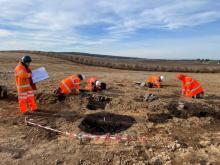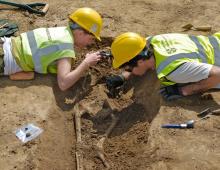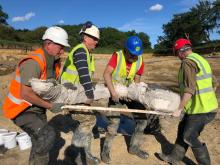A large, hollow bone from the pterosaur was found within the layers of Lincolnshire limestone, shedding new light on the prehistoric life that once soared above the Rutland countryside.
The discovery highlights the important role quarrying plays in uncovering our archaeological history.
Aurelien Colas, Quarry Manager at Heidelberg Materials’ Grange Top quarry said: “It’s truly exciting to see how the quarry has allowed for further understanding of Rutland’s prehistoric past.
“Without quarrying, these fossils would likely never be found as they are buried so deep beneath layers of rocks.”
The full wingspan of the rare fossil is tentatively estimated at between 3.5 to 4 metres and has been identified as a pterosaur (flying reptile) due to the thin-walled nature of the bone, which is typical of flying vertebrates.
As well as being unusually large, it is also the first pterosaur bone in the world dating from the Bajocian age, a period of time in the Middle Jurassic about 170 million years ago. It is also thought to be the first pterosaur recorded in Rutland.
The fossil was discovered by the Peterborough Geological and Palaeontological Group (PGPG), who regularly visit the quarry on weekends to carry out fieldwork, accompanied by Quarry Operative David Whittington.
The Pterosaur fossil will be on display at Rutland County Museum in Oakham by the end of the year, where it has been generously donated by Heidelberg Materials, reflecting the company’s commitment to contributing to the local community’s scientific and archaeological heritage.
Penny Sharp, Director for Places at Rutland County Council, said: “It’s tremendous to have yet another major discovery, following hot on the heels of the Rutland Water Ichthyosaur and 4th century Roman mosaic that have already been unearthed in the County. We’re excited that Rutland County Museum will be home to the pterosaur find and are looking forward to it going on display.”










